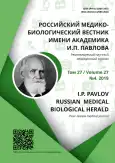Adaptation reactions of hemodynamic systems on artificially modulated stress in healthy individuals
- Authors: Smolyakov Y.N.1, Kuznik B.I.1, Kalashnikova S.A.1, Nolfin N.A.1, Fedorenko E.V.1, Mikhahanov M.M.1
-
Affiliations:
- Chita State Medical Academy
- Issue: Vol 27, No 4 (2019)
- Pages: 443-450
- Section: Original study
- URL: https://journal-vniispk.ru/pavlovj/article/view/11697
- DOI: https://doi.org/10.23888/PAVLOVJ2019274443-450
- ID: 11697
Cite item
Abstract
Aim. To study the influence of artificially created stress on hemodynamic parameters of peripheral microcirculation and variability of the heart rhythm in somatically healthy young individuals.
Materials and Methods. In the study 30 individuals were involved (of them 16 men) with the mean age 18.2±1.1 years. An artificial stress was created using Stroop method. Assessment of characteristics of hemodynamics of microcirculation (HM) was performed by the method of dynamic scattering of light from erythrocytes. The signal was integrated in the form of three hemodynamic indexes: HI (Hemodynamic Indexes). Low frequency index (HI1) was determined by a slow interlayer interaction, high frequency area (HI3) characterized fast shearing of layers. HI2 took intermediate position (precapillary and capillary blood flow). Variability of cardiointervals isolated from pulse component, was assessed by method of variation pulsometry (Heart Rate Variability, HRV).
Results. In the course of study, increase in the heart rate (HR) in the stage of testing was observed that confirms a high extent of stress load. In hemodynamics, redistribution of blood flow was noted toward slow shear velocities (near-wall blood flow). After cessation of stress load, hemodynamic parameters declined and returned to previous values. Parameters characterizing variability of rhythm – LF (sympathetic component), HF (vagal activity), CVI (non-linear parasympathetic index) showed a tendency to growth; here, LF/HF ratio did not change.
Conclusion. In result of the carried out study it was possible to formulate a multifactor picture of variation of parameters of microcirculation and of autonomic regulation of cardiac rhythm specific of reactions of adaptation to induced stress. The quantitative criteria of the obtained shears may be integrated into stress indexes to be used in clinical practice. A portable mDLS sensor may be supplemented with specific assessment criteria and used for monitoring of adaptive reactions induced by stressful situations, and for taking early diagnostic and prognostic decisions in the clinical practice, and for self-control of a patient.
Keywords
Full Text
##article.viewOnOriginalSite##About the authors
Yuri N. Smolyakov
Chita State Medical Academy
Author for correspondence.
Email: smolyakov@rambler.ru
ORCID iD: 0000-0001-7920-7642
SPIN-code: 7440-6632
ResearcherId: R-5740-2017
PhD, Head of the Department of Medical Physics and Informatics
Russian Federation, Gorkogo str. 39a, 672000, ChitaBoris I. Kuznik
Chita State Medical Academy
Email: bi_kuznik@mail.ru
ORCID iD: 0000-0002-2502-9411
SPIN-code: 5807-7229
ResearcherId: D-2743-2018
MD, Professor, Honored Scientist of the Russian Federation, Professor of the Department of Normal Physiology
Russian Federation, Gorkogo str. 39a, 672000, ChitaSvetlana A. Kalashnikova
Chita State Medical Academy
Email: sak-2020@yandex.ru
ORCID iD: 0000-0001-8360-4624
SPIN-code: 4030-5496
Senior Lecturer, Department of Medical Physics and Informatics
Russian Federation, Gorkogo str. 39a, 672000, ChitaNikolay A. Nolfin
Chita State Medical Academy
Email: nol.nikol@mail.ru
ORCID iD: 0000-0003-2570-4293
SPIN-code: 5376-8731
4th year student
Russian Federation, Gorkogo str. 39a, 672000, ChitaEkaterina V. Fedorenko
Chita State Medical Academy
Email: fedorenko@mail.ru
ORCID iD: 0000-0003-0600-7708
SPIN-code: 4711-2143
4th year student
Russian Federation, Gorkogo str. 39a, 672000, Chita, RussiaMankhar Mikhailovich Mikhahanov
Chita State Medical Academy
Email: mikhahanov@mail.ru
ORCID iD: 0000-0002-0620-2047
SPIN-code: 6393-8086
4th year student
Russian Federation, Gorkogo str. 39a, 672000, Chita, RussiaReferences
- Сидоренко Г.И., Комиссарова С.М. Способ оценки фаз стресса у человека // Физиология человека. 2011. Т. 37, №5. С. 73-76.
- McEwen B.S. Stress, adaptation, and disease: Allostasis and allostatic load // Annals of the New York Academy of Sciences. 1998. Vol. 840, №1. P. 33-44. doi: 10.1111/j.1749-6632.1998.tb09546.x
- Stroop J.R. Studies of Interference in Serial Verbal Reactions // Journal of Experimental Psychology. 1935. Vol. 18, №6. P. 643-661.
- Scarpina F., Tagini S. The Stroop color and word test // Frontiers in Psychology. 2017. №8. P. 557. doi: 10.3389/fpsyg.2017.00557
- Сидоренко Г.И., Фролов А.В., Воробьёв А.П. Психоэмоциональные тесты и перспектива их применения в кардиологии // Кардиология. 2004. Т. 44, №6. С. 59.
- Сысоева Т.А. Теоретический анализ механизмов возникновения эмоционального эффекта Струпа // Психология. Журнал Высшей школы экономики. 2014. Т. 11, №1. С. 49-65.
- Смоляков Ю.Н., Калашникова С.А., Федоренко Е.В., и др. Динамические реакции активности коры головного мозга и микроциркуляции на стимулированный стресс // Забайкальский медицинский вестник. 2017. №2. С. 148-153.
- Fine I., Kaminsky A. Speckle-based measurement of the light scattering by red blood cells in vivo // Dynamics and Fluctuations in Biomedical Photo-nics VIII. 2011. Vol. 7898. P. 78980A. doi:10. 1117/12.881991
- Kuznik B.I., Smolyakov Y.N., Davydov S.O., et al. Impact of Fitness Status on the Optically Measured Hemodynamic Indexes // Journal of Healthcare Engineering. 2018. Vol. 2018. Article ID1674931. doi: 10.1155/2018/1674931
- Ладнич Н.А., Смоляков Ю.Н. Возможные варианты формирования интегральных показателей оценки биомедицинских исследований // Информатика и системы управления. 2007. №S1. С. 16-18.
- Shaffer F., Ginsberg J.P. An Overview of Heart Rate Variability Metrics and Norms // Frontiers in Public Health. 2017. №5. P. 258. doi:10.3389/ fpubh.2017.00258
- R Core Team (2018). R: A language and environment for statistical computing. R Foundation for Statistical Computing. Vienna, Austria. Available at: https://www.R-project.org/. Accessed: 2019 March 23.
- Wilcoxon F. Individual Comparisons by Ranking Methods // Biometrics Bulletin. 1945. Vol. 1, №6. P. 80-83. doi: 10.2307/3001968
- Hommel G. A Stagewise Rejective Multiple Test Procedure Based on a Modified Bonferroni Test // Biometrika. 1988. Vol. 75, №2. P. 383-386. doi:10. 1093/biomet/75.2.383
- Kim H.G., Cheon E.J., Bai D.S., et al. Stress and Heart Rate Variability: A Meta-Analysis and Review of the Literature // Psychiatry Investigation. 2018. Vol. 15, №3. P. 235-245. doi: 10.30773/pi.2017.08.17
- Renaud P., Blondin J.P. The stress of Stroop performance: physiological and emotional responses to color-word interference, task pacing, and pacing speed // International Journal of Psychophysiology. 1997. Vol. 27, №2. С. 87-97. doi: 10.1016/S0167-8760(97)00049-4
- Tuchin V.V., ed. Handbook of Photonics for Biomedical Science. CRC Press; 2010.
Supplementary files










